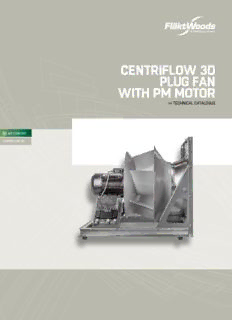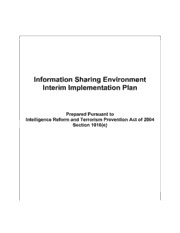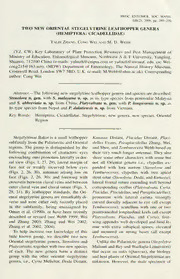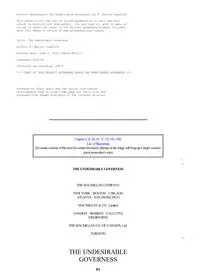
The rise of agrifood technopoles in the Middle East and North Africa PDF
Preview The rise of agrifood technopoles in the Middle East and North Africa
AGRICULTURAL mAnAGemenT, mARkeTInG And fInAnCe 30 WORkInG dOCUmenT The rise of agrifood technopoles in the Middle East and North Africa AGRICULTURAL mAnAGemenT, mARkeTInG And fInAnCe 30 WORkInG dOCUmenT The rise of agrifood technopoles in the Middle East and North Africa by Eva Gálvez-Nogales Rural Infrastructure and Agro-Industries division fOOd And AGRICULTURe ORGAnIZATIOn Of THe UnITed nATIOnS Rome, 2011 The designations employed and the presentation of material in this information product do not imply the expression of any opinion whatsoever on the part of the Food and Agriculture Organization of the United Nations (FAO) concerning the legal or development status of any country, territory, city or area or of its authorities, or concerning the delimitation of its frontiers or boundaries. The mention of specific companies or products of manufacturers, whether or not these have been patented, does not imply that these have been endorsed or recommended by FAO in preference to others of a similar nature that are not mentioned. The views expressed in this information product are those of the author(s) and do not necessarily reflect the views of FAO. All rights reserved. FAO encourages the reproduction and dissemination of material in this information product. Non-commercial uses will be authorized free of charge, upon request. Reproduction for resale or other commercial purposes, including educational purposes, may incur fees. Applications for permission to reproduce or disseminate FAO copyright materials, and all queries concerning rights and licences, should be addressed by e-mail to copyright@fao.org or to the: Chief, Publishing Policy and Support Branch Office of Knowledge Exchange, Research and Extension FAO Viale delle Terme di Caracalla 00153 Rome, Italy © FAO 2011 iii Contents Executive summary v Acronyms vii 1. Introduction 1 2. Food technopoles and related concepts 5 2.1 The notion of food technopoles and related concepts 5 2.2 Territorial development strategies applied to the agrifood sector 7 3. Food technopoles in the Middle East and North Africa region 11 3.1 Regional overview 11 3.2 Early adopters 12 3.3 Late adopters 17 3.4 Laggards 19 4. Discussion and policy recommendations 23 4.1 Analysis of agro-industrial policies in the Middle East and North Africa 23 4.2 Best practices regarding the scope of technopole initiatives 26 4.3 Concluding remarks 33 Bibliography 35 iv List of tables 1. Moroccan food technopoles 13 2. Tunisian technopoles 15 3. Iran technopoles with a partial focus on agrifood 17 v Executive summary The agro-industrial sector of the Middle East and North Africa (MENA) countries has a remarkable growth potential, yet these countries face several constraints that make them net food importers. All through the 2000s, but especially since the food crisis of 2007–2008, MENA countries have devised a plethora of new programmes and policies to strengthen their food industry as a means to improve both their competitiveness and their food security situation. As a rule, the agro-industrial plans launched across the region have three components: (i) the promotion of territorial agro-industrial competitiveness programmes; (ii) the undertaking of administration reforms to improve business environment and attract Foreign Direct Investment (FDI) to the agro-industrial sector; and (iii) negotiation of trade agreements with special provisions for (processed) food products. The present study focuses exclusively on the first component, given its magnitude, innovative character, consistency across the region and likely impact on development and economic growth. The development of agro-industrial competitiveness programmes in the region follows two approaches. The first, employed by North African countries, consists of developing competitive food hotspots by promoting technopoles, clusters and other mechanisms of concentration of agricultural and agro-industrial activity. The second approach, used by Gulf Cooperation Council (GCC) countries, complements the above strategy with the promotion of agricultural investment overseas to secure agricultural raw materials to be processed in the poles. Among the agro-industrial concentration modalities employed in the MENA region, food technopoles are the most common. They can be defined as structured communities dedicated to the development of innovation in the agrifood field. They bring together in one location (or in multiple nearby interrelated locations) the necessary elements for making innovation happen: agro-industries, research and training institutions, and related input and service providers. The present paper tries to assess whether the promotion of food poles is an effective policy instrument that can contribute to the development of the MENA food industry. The existence of several flourishing high- tech technopoles in the region proves that this policy tool can work effectively in this part of the world. Much can be learned from these poles in terms of regional specificities regarding structured development approaches, strategic orientations and governance models for dealing with the business and cultural dualisms relating to research-industry collaboration, public and private and interministerial cooperation. Although many attempts have been made to structure the thinking about the dynamics of innovation and the process of forming technopoles and ensuring their sustainability in MENA countries, very few initiatives have focused on the agrifood sector. In fact, the development of poles in the food sector dates back only 5 to 10 years in most MENA economies. Over this period, MENA countries have reached different levels of development in terms of food technopoles. There exists a whole spectrum of infrastructures ranging from well-organized systems of technopoles in Israel, Tunisia or Morocco, linked to a variety of funding mechanisms, to countries with institutions providing at best subsidized office and industrial space. The present study describes the main programmes and strategies to concentrate agribusiness development in MENA countries. The study of the examples of agribusiness competitiveness initiatives undertaken in the region places an emphasis on the new elements introduced in the revised agro-industrial policy, the common and distinctive features of the territorial agro-industrial programmes across the region, vi and the different level of maturity or sophistication achieved by the different initiatives. MENA’s recent agro-industrial plans based on the food pole concept represents a new generation of policy models that introduces six major changes. First, there has been a transition from top-down to bottom-up agro-industrial policies. Second, innovation and FDI attraction have been pinpointed as a key driver for agro-industrial development in MENA countries. Third, the policy focus has shifted from fostering the competitiveness of individual firms (intercept of the industrial, agricultural, regional development and innovation policies) to institutional innovations that seek to establish a critical mass of inter-linked enterprises, services, investment and infrastructure development. Fourth, the policy has become multidimensional embracing agricultural, industrial, innovation and regional policies, and creating a collaborative framework among all the public agencies concerned. Fifth, it evidences governments’ willingness to attain simultaneously two goals, i.e. ensuring food security and raising the competitiveness of the food industry. Sixth, the new policy centres its efforts on enhancing networking, forging strategic alliances and developing inter-firm and university-corporate linkages. Finally, the study presents findings, conclusions and recommendations based on the data and examples analysed, as well as on international benchmarking of territorial agro-industrial development initiatives. It illustrates the key points highlighted with specific examples of good practice, e.g. regarding the creation of an enabling environment for agro-industrial development, the implementation of successful programmes to promote agro-industrial competitiveness, and the facilitation of dialogue and cooperation between public and private actors, as well as with donors and international organizations. Lessons are drawn from a careful benchmarking with the policies and instruments developed by the European Union (EU) in this field (which have served as a model for elaborating MENA’s policy) that could be adapted to fit the economic reality of MENA countries. vii Acronyms ANIMA Euro-Mediterranean Network of Investment Promotion Agencies BPO business process outsourcing CIHEAM International Centre for Advanced Mediterranean Agronomic Studies ECA European Cluster Alliance EIB European Investment Bank ETTIC Egypt Technology Transfer and Innovation Centres EU European Union FAO Food and Agriculture Organization of the United Nations FDI Foreign Direct Investment FINE Food Innovation Network Europe FTA Free Trade Agreement FTC Food Technology Centre, Egypt GAFTA Greater Arab Free Trade Area GCC Gulf Cooperation Council GDP gross domestic product Globalgap Global Partnership for Good Agricultural Practice GSTP Guilan Science and Technology Park, Rasht ha hectare IASP International Association of Science Parks ICT information and communication technology IPA Investment Promotion Agency ISIPO Small Industries and Industrial Parks Organization, Iran ITC International Trade Centre MEFTA Middle East Free Trade Area MENA Middle East and North Africa MIM Ministry of Industry and Mines, Iran MNA multinational agribusiness MSRT Ministry of Science, Research and Technology, Iran MTI Ministry of Trade and Industry, Egypt NGO non-governmental organization OECD Organisation for Economic Co-operation and Development OIZ Organized Industrial Zone PPP public-private partnership QIZ qualifying industrial zone RTD research and technological development SEZ special economic zone SME small and medium enterprise STREN Scientific and Technological Results Exchange Network TDZ Technology Development Zone TTI technology transfer and innovation UAE United Arab Emirates UNCTAD United Nations Conference on Trade and Development UNDP United Nations Development Programme UNECA United Nations Economic Commission for Africa UNESCO United Nations Educational, Scientific and Cultural Organization UNIDO United Nations Industrial Development Organization WTA World Technopolis Association WTO World Trade Organization 1 1. Introduction The Middle East and North Africa (MENA) region1 has a high potential for shining in the global agribusiness system, starting with a relatively important agribusiness sector at national and international levels;2 followed by a fast-growing domestic demand for agricultural and food products; an excellent culinary reputation, with Lebanon, Morocco and Syria in the lead; a leading position in the fields of agroprocessing and irrigation technologies in some cases (notably Israel); and an expanding land rental market for major agribusiness operations, especially in Morocco and Egypt (Anima, 2010). As a consequence of all the above, the southern Mediterranean rim is becoming increasingly essential in the supply chain of agrifood companies targeting the Euro-African plate and the Middle East, contributing to a de facto positioning of the region relatively to other parts of the world. However, global pressure on the food industry of MENA countries is increasing and efforts to gain ground in the race for competitiveness are needed more than ever. Although agribusiness is a major source of income, employment and food security in the region, the road to its full development is fraught with difficulties, related to infrastructural constraints, trade issues and insufficient access to financial, human and other productive resources (in particular, land and water). As a consequence, MENA countries are net importers of food. In fact, four of these countries (Egypt, Jordan, Morocco and Tunisia) are in the list of major Net Food-Importing Developing Countries of the World Trade Organization (WTO).3 MENA nations have always had food security on top of their priority list, but have placed further emphasis on this issue after the soaring food price crisis of 2008, which exacerbated the vulnerability of their food systems.4 In the wake of such a crisis, efforts to promote agro-industrial development as a way to ensure food security were redoubled. A new agro-industrial strategy has emerged in the MENA region to foster the competitiveness of the sector, while at the same time ensuring food security. This strategy lies on three pillars: • The implementation of ambitious agro-industrial competitiveness programmes following a territorial approach, such as food technopoles, clusters and other mechanisms of concentration of agricultural activity. These programmes are linked to investments in public productive infrastructure, particularly airports and ports. • The deepening of public administration reforms aiming at improving the business environment and attracting private-sector investment into agriculture. Aggressive FDI hosting strategies, targeted at regional firms (beyond the traditional business elite), multinational agribusiness and companies from other sectors already present in the region, have been formulated. • The negotiation of trade agreements within and outside the region, mainly with their main trading partners, i.e. the EU and the United States. 1 According to the World Bank’s classification of countries, the MENA region includes: Algeria, Bahrain, Djibouti, Egypt, Iran, Iraq, Israel, Libyan Arab Jamahiriya, Jordan, Kuwait, Lebanon, Morocco, Oman, Qatar, Saudi Arabia, the Syrian Arab Republic, West Strip and Gaza, Tunisia, United Arab Emirates and Yemen. 2 For example, Egypt is the eighth world producer of horticultural produce; in Syria the agribusiness subsector represents 25 percent of the country’s gross domestic product (GDP); and in Morocco 60 percent of the population makes a living out of the agricultural sector. 3 www.wto.org; This list is for the purposes of the Marrakesh Ministerial Decision on Measures Concerning the Possible Negative Effects of the Reform Programme on Least-Developed and Net Food-importing Developing Countries. 4 For instance, in Yemen, the doubling of the price of wheat and bread has resulted in a 12 percent loss in real income of the poor, which threatens to set back the progress achieved in poverty reduction from 1998 to 2005 (World Bank, 2008).
Description:The list of books you might like

Haunting Adeline

The Strength In Our Scars

The 5 Second Rule: Transform your Life, Work, and Confidence with Everyday Courage

What Happened to You?

Büyük Kyros

Avertissements Agricoles - Pomme de terre - Ile de France - 2006 - 5

CENTRIFLOW 3D PLug FaN WITH PM MOTOR

Extraordinary Gazette of India, 2006, No. 622

DTIC ADA457505: Information Sharing Environment Interim Implementation Plan

Greek Government Gazette: Part 2, 2006 no. 443

Greek Government Gazette: Part 2, 2006 no. 547

Greek Government Gazette: Part 2, 2006 no. 346

JRNMS VOL 92

DTIC ADA484724: Utilizing the Common Criteria for Advanced Student Research Projects

Análise Multivariada de Dados

Sociedade e Comunicacao: Estudos sobre Jornalismo e Identidades

Storia di un barbagianni: un caso di specializzazione forzata

This is Not a Game: A Guide to Alternate Reality Gaming

Two new oriental stegelytrine leafhopper genera (Hemiptera: Cicadellidae)

Diabetes

COMPANY SECRETARIAL PRACTICE A GUIDE TO PRODUCING THE FORMS AND

The Undesirable Governess by F Marion Crawford


